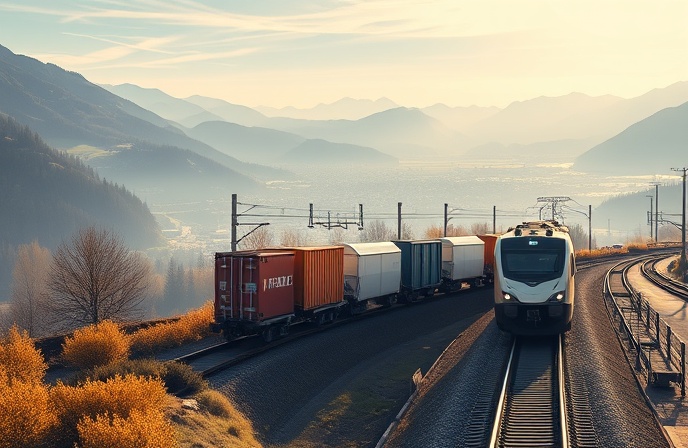Stadler & Keolis: US Rail Signaling & Commuter Experience
Stadler opens Atlanta signaling office, boosting US railway sector. MARTA contract drives expansion. Keolis improves MBTA commuter stations.

Stadler Expands Signaling Division with Atlanta Office Opening, Keolis Enhances Commuter Experience
In a move signaling a significant international expansion, Stadler has established a new signaling office in Atlanta, Georgia. This strategic decision, announced in a recent press release, is directly tied to a substantial signaling contract awarded by the Metropolitan Atlanta Rapid Transit Authority (MARTA) in November 2024. Located adjacent to the Lindbergh Center MARTA station and the MARTA headquarters in uptown Atlanta, the new office signifies a crucial step in the development of Stadler’s North American signaling operations. Simultaneously, Keolis Commuter Services, the operating and maintenance partner for the Massachusetts Bay Transportation Authority (MBTA) commuter-rail service, has completed station cleanup and beautification initiatives on the Fairmount Line. This article will explore these developments and their broader implications for the railway industry.
Stadler’s Expansion into the US Signaling Market
The opening of Stadler’s Atlanta office marks the company’s first major international expansion of its Signaling Division. The primary driver behind this expansion is the aforementioned contract with MARTA, a key player in Atlanta’s public transportation network. Stadler’s signaling solutions are expected to modernize and enhance the efficiency of MARTA’s rail systems, potentially including upgrades to Automatic Train Protection (ATP) and Automatic Train Operation (ATO) systems. ATP systems ensure safe train separation, while ATO systems automate train movement, thereby improving capacity and reducing energy consumption. The strategic location of the new office, near both the MARTA headquarters and a major transit hub, underscores Stadler’s commitment to supporting its North American clients effectively. This proximity will facilitate close collaboration, faster response times, and efficient project management.
Signaling Technology and Its Impact on Rail Operations
Modern signaling systems are crucial for the smooth and safe operation of railway networks. They manage train movements, prevent collisions, and optimize track capacity. The shift towards digital signaling, including the use of European Rail Traffic Management System (ERTMS) Level 2, is a prominent trend in the industry. ERTMS, a standardized signaling and control system, allows for higher speeds, increased safety, and greater interoperability across different railway networks. Stadler’s expertise in signaling, evidenced by this expansion, suggests their commitment to deploying cutting-edge technology that aligns with the industry’s evolving needs. They are ideally positioned to provide solutions that meet the ever-growing demand for efficient, reliable, and safe rail infrastructure.
Keolis’s Commitment to Improving the Commuter Experience
Keolis Commuter Services, as the operating partner for MBTA commuter rail, demonstrates a commitment to enhancing the passenger experience through its Keolis Cares program. Recent initiatives focused on station cleanup and beautification efforts on the Fairmount Line reflect a dedication to providing clean and welcoming stations. Volunteers, community groups, and local officials collaborated to remove debris, plant flowers, and maintain overgrown areas at Four Corners/Geneva Station, Talbot Avenue Station, and Morton Street Station. These improvements not only enhance aesthetics but also contribute to a safer and more pleasant commuting environment. This focus on improving the passenger experience may help boost commuter ridership, improving the public’s view of rail travel, and reducing reliance on single-occupancy vehicles.
The Future of Rail: Industry Trends and Implications
The railway industry is undergoing significant transformation driven by technological advancements and a growing demand for sustainable transportation solutions. Stadler’s expansion underscores the rising importance of advanced signaling technologies in this evolution. The integration of digital systems, automation, and data analytics will be crucial for optimizing network performance, improving safety, and enhancing the passenger experience. Simultaneously, the efforts of operators like Keolis to improve the aesthetic and functional elements of commuter stations reflect a holistic approach to rail service, acknowledging the significance of the entire journey. These trends point to a future where rail travel is efficient, safe, user-friendly, and integrated within a broader context of sustainable urban mobility. Increased investment, both in infrastructure and in passenger experience, will be vital for the sustained growth and success of the railway sector.
Company Summary
Stadler Rail is a Swiss manufacturer of rail vehicles, offering a broad portfolio that includes trains, trams, and locomotives. Their signaling division provides integrated solutions, including signaling systems, train control, and infrastructure management. Stadler has a significant presence globally, with manufacturing and service facilities worldwide, contributing to its capacity for major projects like this one in Atlanta. Keolis is a global provider of public transport services, operating in various countries, and a major player in the North American commuter rail market. Their operations include managing, maintaining, and improving train systems, ensuring passenger satisfaction.




